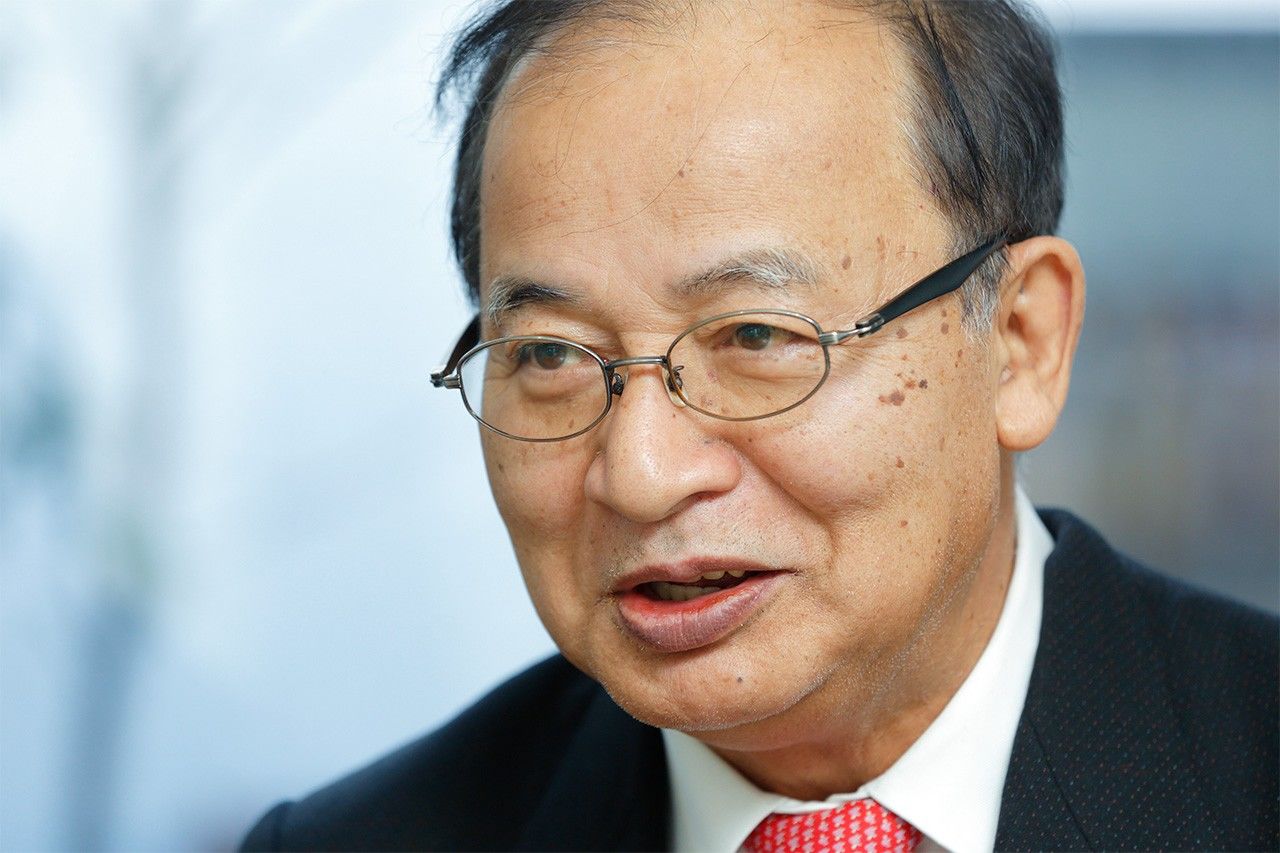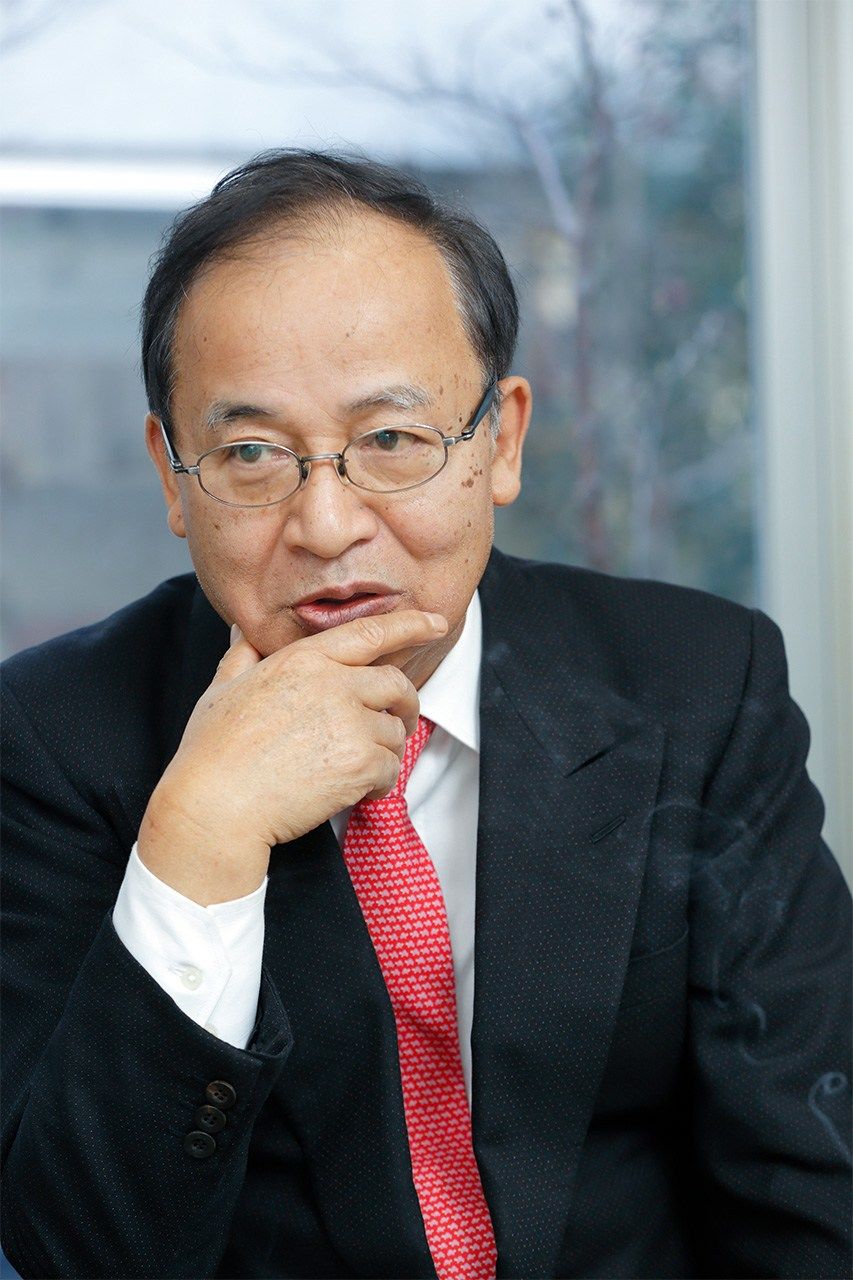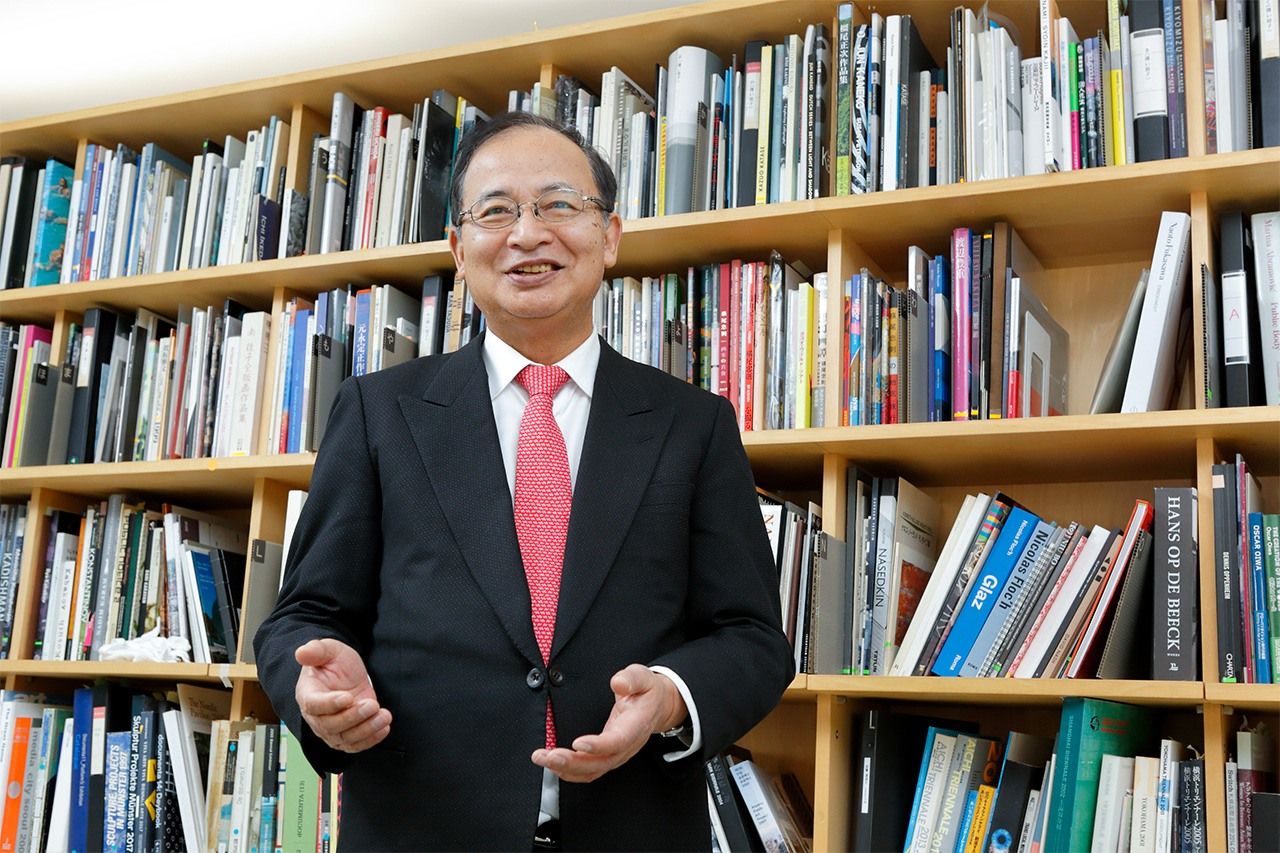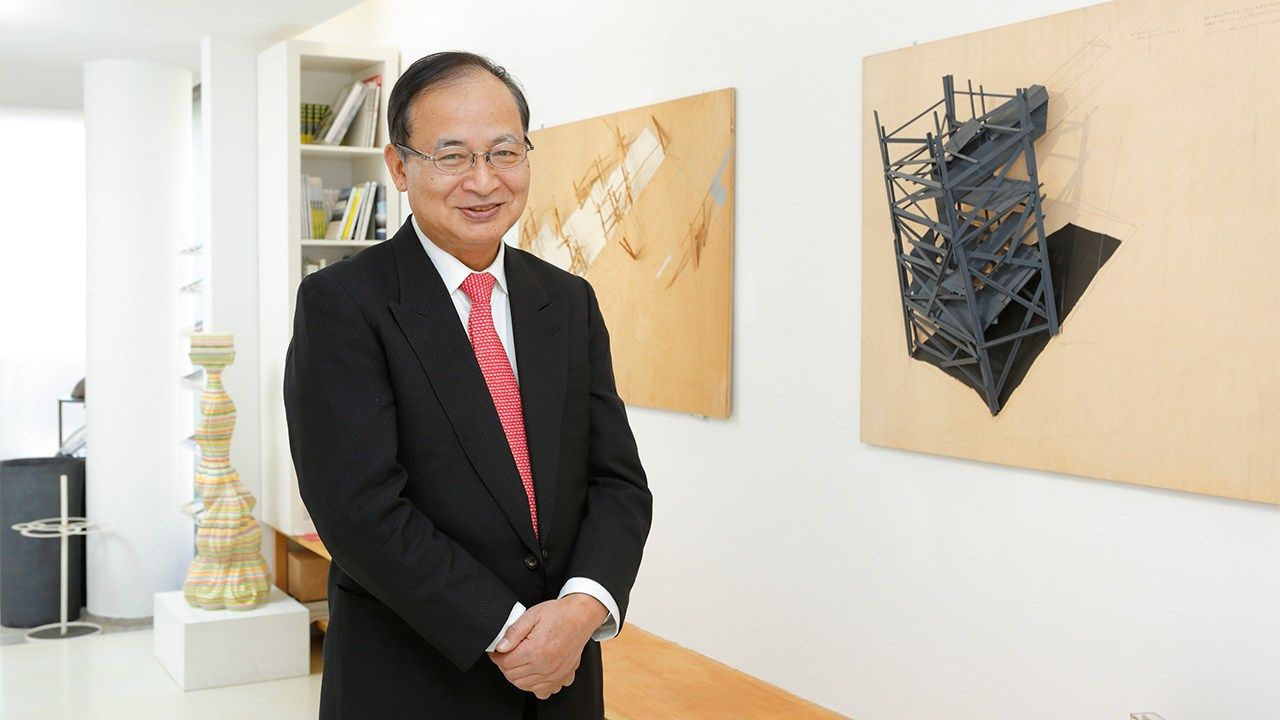
Kitagawa Fram: Contemporary Art to the Rescue of Rural Japan
Culture Society Art- English
- 日本語
- 简体字
- 繁體字
- Français
- Español
- العربية
- Русский
Art director Kitagawa Fram has won plaudits for contemporary-art projects that celebrate the traditional culture and natural assets of Japan’s endangered regions. From his urban headquarters in the Art Front Gallery in Daikanyama, Tokyo, he routinely travels to remote corners of the archipelago in his tireless crusade to help revitalize Japan’s rural communities and preserve their relationship with the natural environment.
Among Kitagawa’s most celebrated undertakings are the Echigo-Tsumari Art Triennale in Niigata Prefecture and the Setouchi Triennale in the Seto Inland Sea. Both are drawing growing numbers of visitors, foreign as well as Japanese, to remote areas threatened by depopulation.
From Snowbound Backwater to Arts Mecca
Regional art festivals have become commonplace in Japan in recent years, but it was Kitagawa’s Echigo-Tsumari Art Triennale, launched in 2000, that sparked the trend. It also set a standard that few have been able to match.
The initial impetus for the project was the central government’s policy of consolidating rural municipalities under the 1995 Act on Promotion of Decentralization Reform. The government’s plan called for merging all six municipalities in the region known as Echigo-Tsumari in southern Niigata Prefecture, a mountainous area dotted by numerous hamlets, many of them cut off from the rest of the world each winter by heavy snow. To overcome local opposition to the merger, prefectural officials drew up a package of “regional revitalization” measures targeting the six municipalities—Tōkamachi, Kawanishi, Nakasato, Tsunan, Matsudai, and Matsunoyama. Kitagawa visited the area for the first time in 1996, when he was summoned to assist.
“The prefectural government wanted an art project to ‘energize the region,’” he recalls. That was a tall order for an area roughly the size of Tokyo’s 23 wards with about 80,000 inhabitants scattered among more than 200 villages (at that time).
Kitagawa pondered the history of those hamlets, which had grown up in harmony with nature and survived blizzards and famines over the centuries, only to face extinction from depopulation and administrative rationalization. “The basic goal of the mergers was to streamline local administration,” says Kitagawa. “They talk about decentralization, but what it really comes down to is jettisoning the smaller communities in the interests of efficiency. I wanted to do exactly the opposite of that and put the spotlight squarely on each of those mountain villages.”
The solution he came up with was a massive exhibition of earth art and other innovative works celebrating and utilizing the local culture and natural environment. Artists and architects from Japan and abroad set to work creating objects, installations, and environmental art that made use of the region’s local assets, from its scenery—dotted by beautiful terraced rice fields—to its closed schools and abandoned farmhouses. Anchored by art centers, museums, and key installations around the region, the artworks (some temporary, others permanent) would become the focus of the Echigo-Tsumari Art Triennale, a region-wide international art festival to be renewed once every three years.
Not everyone was thrilled about the plan. In fact, Kitagawa had to delay the first Triennale for a year as he struggled to overcome opposition from skeptical locals.
Kitagawa himself recognized that an art exhibition alone would do little to address the region’s underlying problems. “What was needed was for outsiders to engage with the local community on a long-term basis,” says Kitagawa.
Enter the Kohebitai, or “little snakes,” a loose organization of volunteers (consisting mainly of students from the Tokyo area at the outset) that journeyed to Echigo-Tsumari to assist with installations and festival operations. “From the start, I was conscious of the importance of interaction between rural and urban and between the older and younger generations. In the country, people keep working in the fields even when they’re bent with age. It’s very edifying for city kids to interact with the elderly women of these villages. In the course of their daily activities, the artists, staff, and volunteers bonded with the local people, and that collaboration became the driving force behind the project. I was overjoyed when the second Triennale came to fruition in 2003, because I knew it had to continue in order to achieve anything worthwhile.”
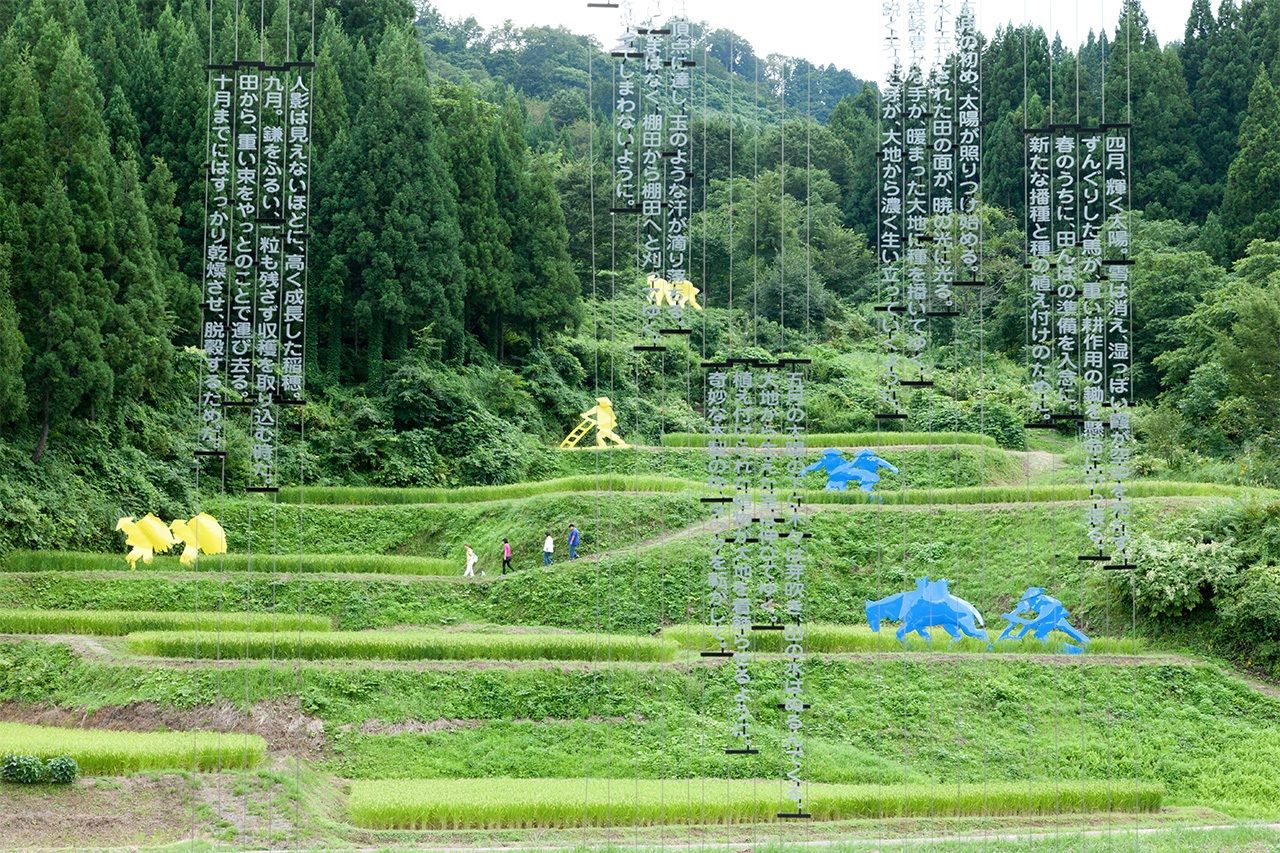
Ilya and Emilia Kabakov, The Rice Fields (2000). The installation integrated sculptures depicting farmers and text explaining the cultivation process into the landscape. (Photo by Nakamura Osamu)
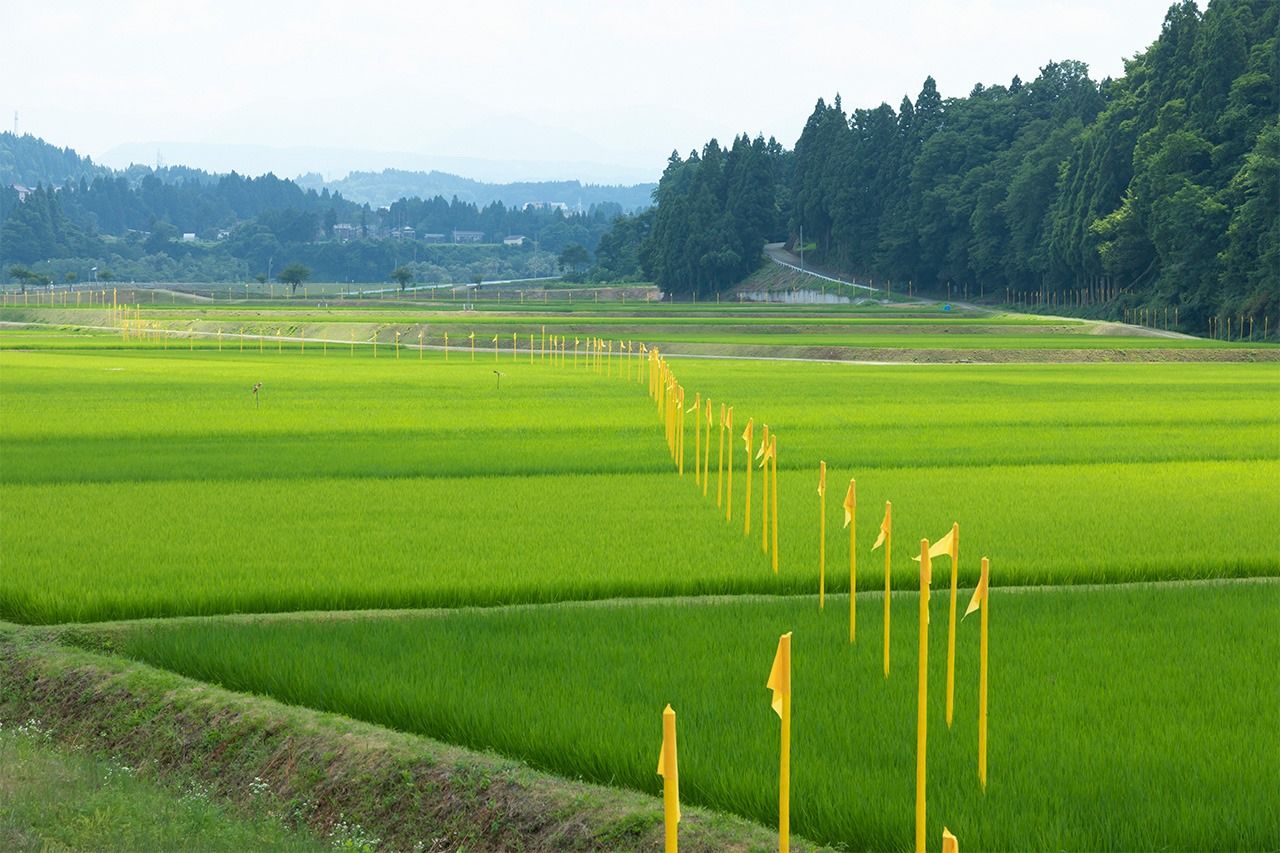
Yukihisa Isobe, Where Has the River Gone? Some 600 yellow flags mark the winding course of the old Shinano River, which has been straightened, dammed, and paved with concrete over the years. (Photo by Nakamura Osamu)
But the crucial turning point for the project may have been the Niigata Chūetsu Earthquake of October 2004. A number of communities in the Echigo-Tsumari area were hard hit by the quake, and the project’s artists, architects, staff, and volunteers naturally did what they could to help. One product of their efforts was the conversion of a historic farmhouse into a restaurant-inn called Ubusuna House, staffed by local women. Abandoned after the quake, the vacant building could easily have turned into a community liability. Instead, Ubusuna House racked up ¥14 million in sales during the third Echigo-Tsumari Art Triennale of 2006 and became a model for others to follow.
As Kitagawa tells it, the atmosphere surrounding the 2006 Triennale was utterly different from that of the previous two. “By the autumn of 2005, the residents were telling local officials that it was time to get busy with preparations for the 2006 Triennale. The officials were gobsmacked,” says Kitagawa. “More than half of the remaining villages—including some that were down to a handful of households—said they wanted to be involved. And instead of withholding information about vacant homes in the name of privacy concerns, they were actively offering up abandoned buildings for our use. Elderly residents, who had initially formed the core of the opposition, emerged as our biggest supporters. The festival had become a triennial event that the whole community looked forward to.”
Five of the six municipalities originally targeted for consolidation merged into the city of Tōkamachi in October 2005. The village of Tsunan opted out, but it continued to participate in the art project.
The Echigo-Tsumari Art Triennale has produced roughly 150 new works every three years and attracted the attention of art lovers and travelers worldwide. Between July and September 2018, a record 550,000 visitors from Japan and abroad converged on Tōkamachi and Tsunan for the seventh Echigo-Tsumari Art Triennale. “It’s an opportunity to explore the region’s backroads and hamlets and interact with its people while experiencing some exciting contemporary art,” says Kitagawa. “That’s the big attraction.”

Left: Ubusuna House, a restored farmhouse in Tōkamachi, originally dating to 1924. (Photo by Kawase Kazue) Right: The first floor of Ubusuna House includes a restaurant that serves local cuisine on handcrafted pottery, while the second floor features a tea room and ceramics gallery. (Photo by Yanagi Ayumi)
Island Hopping through the Setouchi Triennale
After the success of the third Echigo-Tsumari Art Triennale, Kitagawa turned his attention to regional revitalization in and around the Seto Inland Sea. Building on his experience in Echigo-Tsumari, he organized the Setouchi Triennale, an art festival taking the form of a tour through the region’s islands and ports. The first Setouchi Triennale was held in 2010 with the participation of seven islands plus the port of Takamatsu, capital of Kagawa Prefecture. With the second Triennale in 2013, the tour added another five islands and the port of Uno in Okayama Prefecture.
A natural starting point for the project was the island of Naoshima, where a beautiful contemporary art complex had already opened in 1992 with funding from Benesse Holdings and the Fukutake Foundation. From Naoshima, Kitagawa turned his attention to Teshima—once fouled by illegal industrial dumping, now the pristine site of a stunning art museum—and Ōshima, home to a sanatorium where leprosy patients were isolated for many years under a misguided law that persisted until 1996.
“One thing I learned in my experience with Echigo-Tsumari is that nothing gets the locals involved like food. The residents really come alive when they have the chance to serve their regional specialties to visitors. So, on Teshima, we started out by turning a vacant house and garden into Shima Kitchen, which serves homestyle cooking with help from local women.”
On Ōshima, now inhabited only by a few dozen elderly residents who chose to remain behind, the participating artists initially displayed works at the Triennale introducing housewares and the autopsy table used at the sanatorium to show visitors the conditions inmates were made to endure. Eventually, artists came to stay for long stretches on the island as they set to work on their projects.
“I think the residents on Ōshima want to leave behind some record of their lives for future generations. Most don’t have descendents of their own, which is precisely why they want the island to become a place where children can play and learn in the future. It would be great if our project could help move things in that direction.”

Left: Shima Kitchen, an abandoned house converted to a restaurant on the island of Teshima in the Seto Inland Sea. (Photo by Nakamura Osamu) Right: Tashima Seizō, Life of N: 70 Years on Ōshima—A Room with a Wooden Pot. (Photo by Kioku Keizō)
The Setouchi Triennale makes certain demands on visitors. It takes about an hour to fly from Tokyo to Takamatsu. From there, the ride out to the islands varies depending on the weather and the daily ferry schedule. But as Kitagawa sees it, getting there is half the fun. “The scenery changes dramatically as you move from one island to the next,” he says. “I think people all over the world are beginning to rediscover the rewards of travel that takes a bit more time and effort and isn’t completely predictable, like a package tour.”
Kitagawa says that both of the festivals tend to draw urban women in their thirties, forties, and fifties. “For them, these events offer a rare opportunity to get out and interact with nature and the local residents through the medium of art, while also enjoying regional home cooking. This approach is consistent with the United Nations’ guidelines on sustainable tourism. Travel shouldn’t be just about congregating at famous tourist spots. It’s also important to visit new places and meet new people. There’s a kind of personal interaction in the country that has largely disappeared from our efficiency-oriented cities.”
Forging International Connections
The Echigo-Tsumari support apparatus known as the Kohebitai now boasts some 3,000 volunteers, including a substantial number who come from neighboring countries like Hong Kong, Taiwan, and China to help out. About one-fourth of the 10,000 volunteers who assist with the Setouchi Triennale are non-Japanese. Foreign embassies and foundations have lent their support to the projects as well. For the third Echigo-Tsumari Art Triennale, Ifugao province in the Philippines donated a hut from one of its traditional rice terraces—designated a UNESCO World Heritage site—to be rebuilt in the Shimojō district of Echigo-Tsumari, also known for its terraced paddies. International exchange continues even now between the farming villages of Echigo-Tsumari and Ifugao.
Partly as a result of such interchange, festivals of the sort Kitagawa helped spearhead are beginning to take hold elsewhere in Asia. “Taiwan already has quite a few earth-art festivals modeled on ours,” says Kitagawa. He also reports efforts to launch similar projects in various parts of China, where rapid urban migration is having a devastating impact on regional culture. “If some of our Japanese volunteers go overseas to help with festivals celebrating the local culture and natural environment, they’ll forge human connections in all those new places. That expanding network could become a major force for good. It’s a ray of hope in a world where the outlook for the future often seems dim.”
Pitfalls of Art Tourism
The Echigo-Tsumari Art Triennale has also inspired similar programs throughout Japan. In fact, an estimated 2,000 or so art-centered events are held in Japan each year in the name of regional revitalization. However, very few of these continue for any length of time. Developing art as a regional asset is not something one can do overnight. Kitagawa is critical of one-off events that use art as a disposable commodity to lure foreign tourists.
“In our capitalist system, where economic efficiency rules supreme, artists are continually making tough choices about how to make a living and how to involve themselves in social issues through their work. Rather than seeking out fame and money, top-name artists are getting involved in rural art festivals to benefit those regions. As long as their works are installed there, they can’t be sold and remain a resource for the local community.” In Echigo-Tsumari, with its brutal winters, many of the installations are necessarily ephemeral in nature, but every effort is made to preserve those that can be preserved—generally 30 or 40 of the roughly 150 works created for each Triennale.
“I think creating art is like raising children,” says Kitagawa. “You spend time and money, and you don’t expect immediate results. Many of the works in the Echigo-Tsumari and Setouchi festivals take months or years to create on-site, and that opens the door to participation and cooperation by the local community. We’re focused on long-term community building through close collaboration with the local residents.”
In dozens of villages and towns around Echigo-Tsumari and the Seto Inland Sea, that collaboration is proceeding apace in preparation for the two regions’ upcoming art festivals, scheduled for 2021 and 2022.
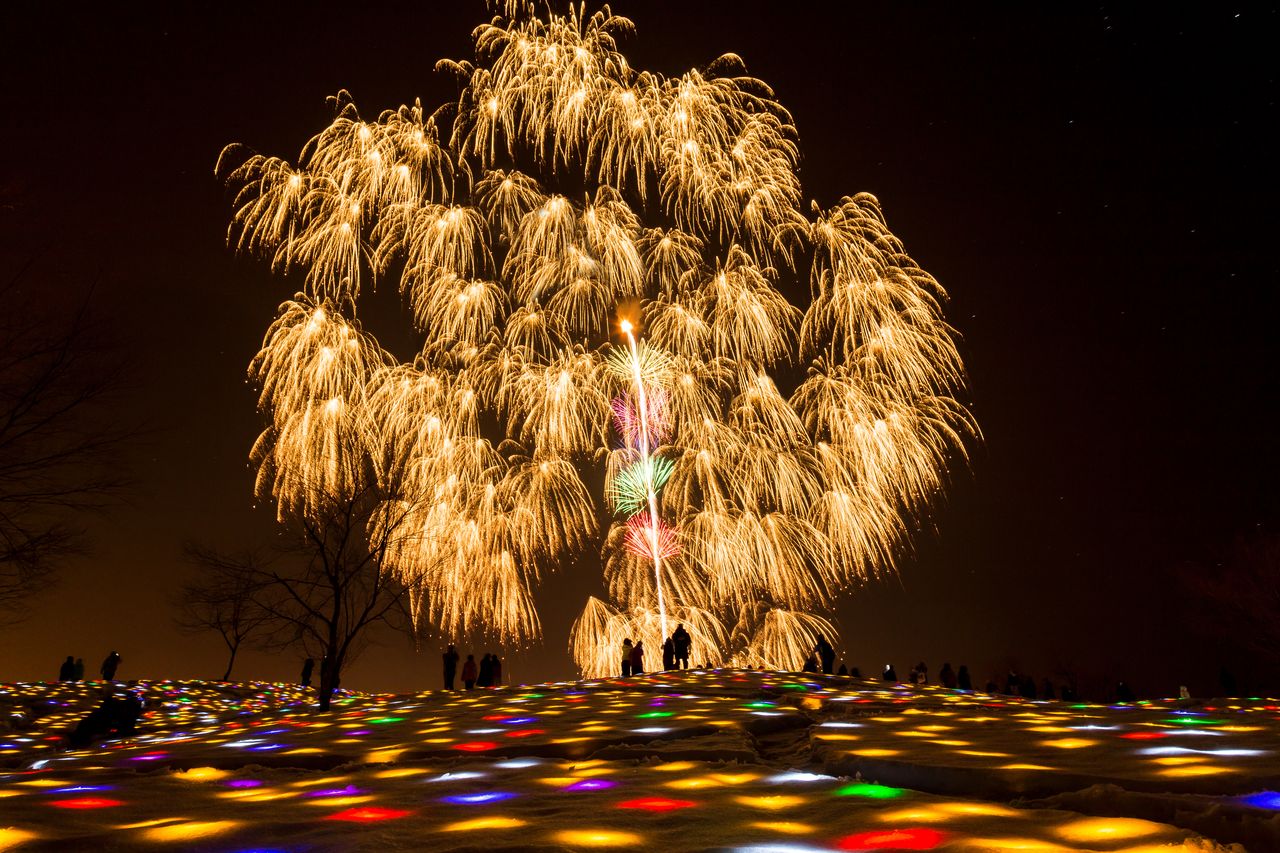
The Echigo-Tsumari Snow Fireworks is a multimedia event held annually (though canceled in 2020). The outdoor light installation Gift for Frozen Village 2019, shown here, is by Takahashi Kyōta. (Photo by Yanagi Ayumi)
(Originally published in Japanese, based on an interview by Itakura Kimie of Nippon.com. Photos by Ōkubo Keizō except where otherwise noted. Banner photo: Art Director Kitagawa Fram at Art Front Gallery in Daikanyama, Tokyo.)
